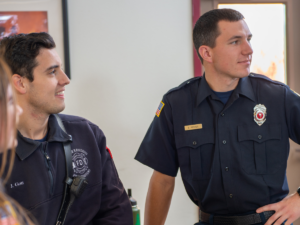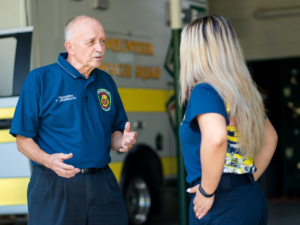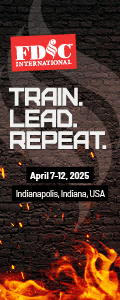Addressing Cliques in the Fire Service
March 7, 2023
By Chief John M. Buckman III
The fire service spends a lot of time trying to recruit additional people to volunteer. What if the same effort was put into retaining volunteer personnel? I would contend it is more beneficial to a department to have a stronger experienced group of volunteers who are committed to service than having a rotating door where people come and go constantly.
There are many factors that impact retention. Some of these are out of the fire department’s control, such as:
- Changes in family structure
- Children added to the family
- Job responsibility changes
- Job requires transfer to another city/town
- Financial situations
- Medical conditions impacting the family, including parents
 However, not all of these situations have to result in the permanent loss of the volunteer to the department. Local leadership should find out why a volunteer is leaving the department and have flexible policies and procedures in place that allow members to adapt their involvement based on their current situation and life stage. For those who do leave the department, let them know they are welcome back if circumstances change in the future.
However, not all of these situations have to result in the permanent loss of the volunteer to the department. Local leadership should find out why a volunteer is leaving the department and have flexible policies and procedures in place that allow members to adapt their involvement based on their current situation and life stage. For those who do leave the department, let them know they are welcome back if circumstances change in the future.
The National Volunteer Fire Council (NVFC) released a Volunteer Retention Research Report in August 2020 to look into why volunteers stay in and leave the fire and emergency services. An alarming 64% of current volunteers reported that their department has a problem with retention. Many of the top factors identified from the survey as reasons volunteers leave relate to leadership. These include leadership that volunteers deem uncaring, unsupportive, ineffective, and having unclear or unrealistic expectations for volunteer performance.
Former volunteers cited a lack of department cohesion and unsupportive leadership as their main reasons for leaving. The top two reasons for leaving were a department atmosphere full of cliques and groups that exclude others, and department leadership that doesn’t focus on or support the needs of members.
Let’s focus on the issue of cliques. Cliques can be positive, but in many cases they can be negative. Cliques form for several reasons such as:
- Similar age and personality types
- Volunteer at the department for a long period of time
- Have similar hobbies
- Shared experiences
- Feel slighted by the department
- Uncomfortable with potential for promotion
- Lack of positive feedback
When others empathize and support your feelings, it can strengthen your bond with those who think like you. This may happen when one group of volunteers receives the majority of positive feedback, leaving other volunteers out. It can be comforting and validating to find other volunteers who feel overlooked. Similarly, the top performers may seek each other out exclusively.
One of the first steps in dealing with cliques is to admit they exist in every organization. It is the cliques’ impact that can be addressed by acknowledging and understanding them, and working to ensure the clique has a positive impact on the group and the department.
What are some of the signs of a negative clique in your department?
- Gossiping about others
- Spreading rumors
- Bullying, harassment, and hazing
- Exclusion of others from informal events
These types of cliques can have a detrimental effect on department/company morale and activity. Volunteers can lose their motivation to participate when they feel left out, overlooked, disrespected, or unsafe.
Members of a clique have limited perspectives because they hear the same messages over and over again from the same voices. Official communications is one way to broaden a volunteer’s perspective about the department.
 Here are some actions you can take to reduce the negative impact of cliques.
Here are some actions you can take to reduce the negative impact of cliques.
- Conduct team-building activities with all members of the department.
- As a leader don’t get caught up in one clique. Management by Walking Around (MBWA) is important to handling cliques. Be at the station and get out of your office.
- Meet with clique members and explain the negative impact they are having on the members of the department. The group may not realize their negative impact, and this may make them aware of the need to change their behavior. Make sure you don’t accuse the group of any wrongdoing unless you can back the accusation up with evidence of their specific action and the outcome.
- Review department values and mission with the membership. The department exists because of the public need for emergency services. Sometimes cliques can believe they are the most important mission of the department.
- Hold social events for everyone on the department.
- Enforce rules fairly, firmly, and in a friendly manner.
- Treat all members with fairness and respect. Leaders should not be perceived as favoring some over others.
It is a leader’s responsibility to set the tone of a department’s culture. To retain volunteers, foster a positive and healthy environment for those who serve, and support all members, leaders must take action to prevent cliques from making the volunteer experience bad for others.
Remember, there is a lot of competition for a volunteer’s time. If the volunteer isn’t getting a fulfilling and personally rewarding experience at the fire department, they will ultimately leave the department. It is up to leadership to make sure the department is a supportive, inclusive, and welcoming place that volunteers want to spend their time.
For those who read this article and think this is not how we led in the past, I remind you that the old days weren’t necessarily all that great either. Today’s leading environment is not better or worse, just different. Whether that “different” ends up being better or worse is up to you. I contend that different is better if the department is keeping up with the development of their community and membership.
For additional information about retaining volunteers, read the NVFC’s Volunteer Retention Research Report here.
John M. Buckman III served as a German Township (IN) fire chief managing volunteers for 35 years. He currently serves as education coordinator for the International Association of Fire Chiefs’ (IAFC) Volunteer and Combination Officers Section. He received the National Volunteer Fire Council’s (NVFC) Chief James P. Seavey Sr. Health & Wellness Leadership Award in 2022 and the NVFC Lifetime Achievement Award in 2013. He served as the Indiana Fire Academy Director for 15 years, is a past president of the IAFC, and has authored over 150 articles and several books.



